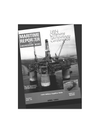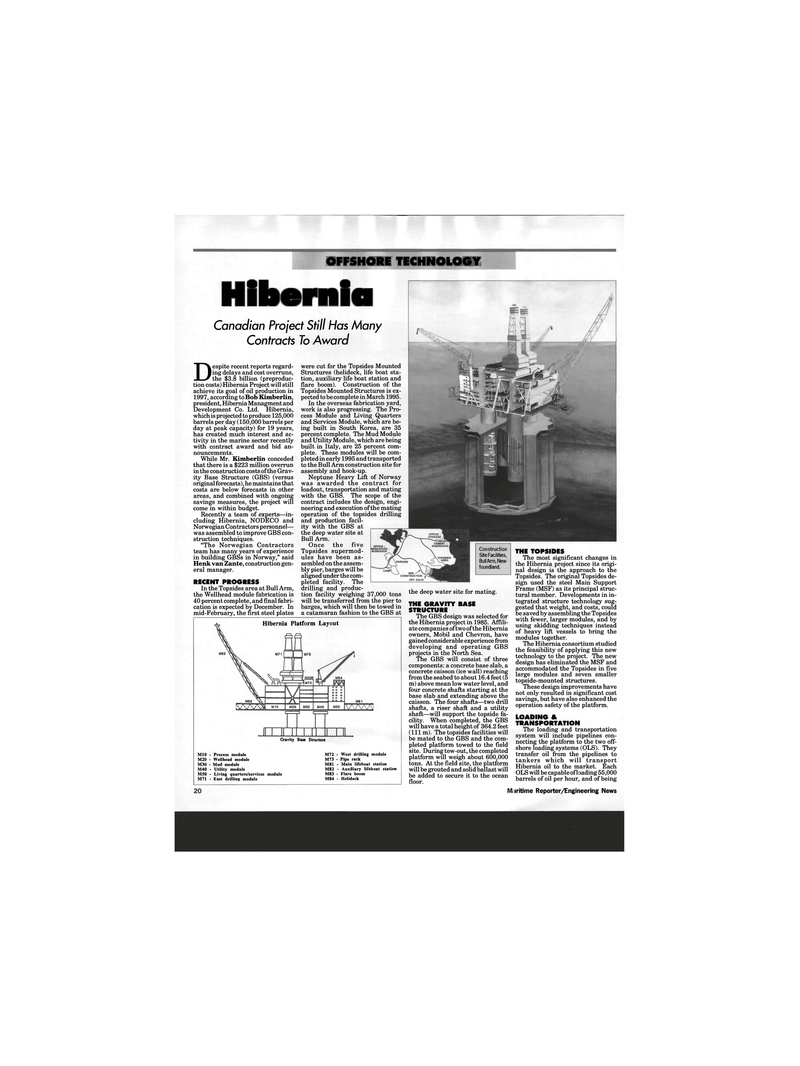
Page 18: of Maritime Reporter Magazine (April 1994)
Read this page in Pdf, Flash or Html5 edition of April 1994 Maritime Reporter Magazine
OFFSHORE TECHNOLOGY
Construction
Site Facilities,
Bull Arm, New- foundland. the deep water site for mating.
THE GRAVITY BASE
STRUCTURE
The GBS design was selected for the Hibernia project in 1985. Affili- ate companies of two of the Hibernia owners, Mobil and Chevron, have gained considerable experience from developing and operating GBS projects in the North Sea.
The GBS will consist of three components: a concrete base slab, a concrete caisson (ice wall) reaching from the seabed to about 16.4 feet (5 m) above mean low water level, and four concrete shafts starting at the base slab and extending above the caisson. The four shafts—two drill shafts, a riser shaft and a utility shaft—will support the topside fa- cility. When completed, the GBS will have a total height of 364.2 feet (111 m). The topsides facilities will be mated to the GBS and the com- pleted platform towed to the field site. During tow-out, the completed platform will weigh about 600,000 tons. At the field site, the platform will be grouted and solid ballast will be added to secure it to the ocean floor.
THE TOPSIDES
The most significant changes in the Hibernia project since its origi- nal design is the approach to the
Topsides. The original Topsides de- sign used the steel Main Support
Frame (MSF) as its principal struc- tural member. Developments in in- tegrated structure technology sug- gested that weight, and costs, could be saved by assembling the Topsides with fewer, larger modules, and by using skidding techniques instead of heavy lift vessels to bring the modules together.
The Hibernia consortium studied the feasibility of applying this new technology to the project. The new design has eliminated the MSF and accommodated the Topsides in five large modules and seven smaller topside-mounted structures.
These design improvements have not only resulted in significant cost savings, but have also enhanced the operation safety of the platform.
LOADING &
TRANSPORTATION
The loading and transportation system will include pipelines con- necting the platform to the two off- shore loading systems (OLS). They transfer oil from the pipelines to tankers which will transport
Hibernia oil to the market. Each
OLS will be capable of loading 55,000 barrels of oil per hour, and of being 20 Circle 282 on Reader Service Card Maritime Reporter/Engineering News
Hibernia Platform Layout
Hibernia
Canadian Project Still Has Many
Contracts To Award
M10 - Process module
M20 - Wellhead module
M30 - Mud module
M40 - Utility module
M50 - Living quarters/services module
M71 - East drilling module
M72 - West drilling module
M73 - Pipe rack
M81 - Main lifeboat station
M82 - Auxiliary lifeboat station
M83 - Flare boom
M84 - Helideck
Gravity Base Structure
Despite recent reports regard-ing delays and cost overruns, the $3.8 billion (preproduc- tion costs) Hibernia Project will still achieve its goal of oil production in 1997, according to Bob Kimberlin, president, Hibernia Managment and
Development Co. Ltd. Hibernia, which is projected to produce 125,000 barrels per day (150,000 barrels per day at peak capacity) for 19 years, has created much interest and ac- tivity in the marine sector recently with contract award and bid an- nouncements.
While Mr. Kimberlin conceded that there is a $223 million overrun in the construction costs of the Grav- ity Base Structure (GBS) (versus original forecasts), he maintains that costs are below forecasts in other areas, and combined with ongoing savings measures, the project will come in within budget.
Recently a team of experts—in- cluding Hibernia, NODECO and
Norwegian Contractors personnel— was assembled to improve GBS con- struction techniques. "The Norwegian Contractors team has many years of experience in building GBSs in Norway," said
Henk van Zante, construction gen- eral manager.
RECENT PROGRESS
In the Topsides area at Bull Arm, the Wellhead module fabrication is 40 percent complete, and final fabri- cation is expected by December. In mid-February, the first steel plates were cut for the Topsides Mounted
Structures (helideck, life boat sta- tion, auxiliary life boat station and flare boom). Construction of the
Topsides Mounted Structures is ex- pected to be complete in March 1995.
In the overseas fabrication yard, work is also progressing. The Pro- cess Module and Living Quarters and Services Module, which are be- ing built in South Korea, are 35 percent complete. The Mud Module and Utility Module, which are being built in Italy, are 25 percent com- plete. These modules will be com- pleted in early 1995 and transported to the Bull Arm construction site for assembly and hook-up.
Neptune Heavy Lift of Norway was awarded the contract for loadout, transportation and mating with the GBS. The scope of the contract includes the design, engi- neering and execution of the mating operation of the topsides drilling and production facil- ity with the GBS at the deep water site at
Bull Arm.
Once the five
Topsides supermod- ules have been as- sembled on the assem- bly pier, barges will be aligned under the com- pleted facility. The drilling and produc- tion facility weighing 37,000 tons will be transferred from the pier to barges, which will then be towed in a catamaran fashion to the GBS at

 17
17

 19
19
